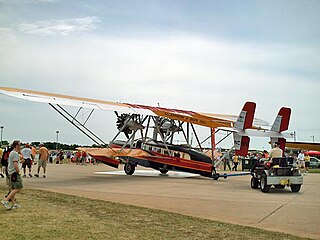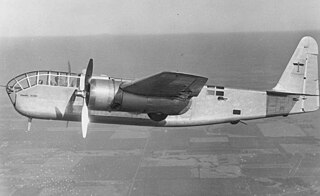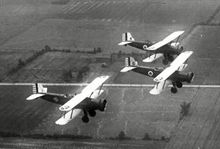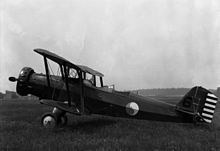
The Lockheed P-38 Lightning is an American single-seat, twin piston-engined fighter aircraft that was used during World War II. Developed for the United States Army Air Corps (USAAC) by the Lockheed Corporation, the P-38 incorporated a distinctive twin-boom design with a central nacelle containing the cockpit and armament. Along with its use as a general fighter, the P-38 was used in various aerial combat roles, including as a highly effective fighter-bomber, a night fighter, and a long-range escort fighter when equipped with drop tanks. The P-38 was also used as a bomber-pathfinder, guiding streams of medium and heavy bombers, or even other P-38s equipped with bombs, to their targets. Used in the aerial reconnaissance role, the P-38 accounted for 90 percent of American aerial film captured over Europe. Although it was not designated a heavy fighter or a bomber destroyer by the USAAC, the P-38 filled those roles and more; unlike German heavy fighters crewed by two or three airmen, the P-38 with its lone pilot was nimble enough to compete with single-engine fighters.

The Curtiss Falcon was a family of military biplane aircraft built by the American aircraft manufacturer Curtiss Aeroplane and Motor Company during the 1920s. Most saw service as part of the United States Army Air Corps as observation aircraft with the designations O-1 and O-11, or as the attack aircraft designated the A-3 Falcon.

The Keystone B-3A was a bomber aircraft developed for the United States Army Air Corps by Keystone Aircraft in the late 1920s.

The Keystone B-5 is a light bomber made by the Keystone Aircraft company for the United States Army Air Corps in the early 1930s. The B-5A was a Keystone B-3A with Wright Cyclone rather than Pratt & Whitney engines.

The Douglas YOA-5 was an amphibious aircraft designed for the United States Army Air Corps, based on the Navy's Douglas XP3D. Although a prototype was built, it did not enter production.

The Douglas B-23 Dragon is an American twin-engined bomber developed by the Douglas Aircraft Company as a successor to the B-18 Bolo.

The Sikorsky S-38 was an American twin-engined ten-seat sesquiplane amphibious aircraft. It was Sikorsky's first widely produced amphibious flying boat, serving successfully for Pan American Airways and the United States military.

The Douglas DT bomber was the Douglas Aircraft Company's first military contract, forging a link between the company and the United States Navy. Navy Contract No. 53305 of April 1, 1921, required only 18 pages to set out the specifications that resulted in the purchase of three DT folding-wing aircraft.

The Douglas O-46 was an observation aircraft used by the United States Army Air Corps and the Philippine Army Air Corps. It entered service in the late 1930s, and saw action in WW2. It became obsolescent later in the war as an observation craft, but was used for liaison, training, and ASW patrols. One airframe has survived as a museum piece into the present day.

The North American O-47 is an American observation fixed-wing aircraft monoplane designed in the mid-1930s and used by the United States Army Air Corps during the Second World War. It has a low-wing configuration, retractable landing gear, and a three-blade propeller.

The Curtiss O-52 Owl was an observation aircraft used by the United States Army Air Corps before and during World War II. They were used for anti-submarine searches in Americas and by lend-lease also used on the Eastern Front in Europe by the Soviets.

The Stearman XA-21 was a competitor in a United States Army Air Corps competition for a twin-engined attack aircraft which led to the Douglas A-20 Havoc, Martin A-22 Maryland and North American B-25 Mitchell.

The Vought O2U Corsair was a 1920s biplane scout and observation aircraft. Developed by Vought Corporation, the O2U was ordered by the United States Navy (USN) in 1927. Powered by a 400 hp (298 kW) Pratt & Whitney R-1340 engine, it incorporated a steel-tube fuselage structure and a wood wing structure with fabric covering. Many were seaplanes or amphibians.

The Douglas O-2 was a 1920s American observation aircraft built by the Douglas Aircraft Company, powered by the Liberty engine of WW1 fame, with some later variants using other engines. It was developed into several versions, with 879 being produced in total. It was used in combat by the Chinese Air Force in the 1930s and also was the basis for a successful mailplane version.

The Consolidated Model 2 was a training airplane used by the United States Army Air Corps, under the designation PT-3 and the United States Navy under the designation NY-1.

The Consolidated Model 21 was an American two-seat training aircraft built by the Consolidated Aircraft Company. It was used by the United States Army Air Corps with the designation PT-11 and the United States Coast Guard under the designation N4Y.

The Curtiss T-32 Condor II was a 1930s American biplane airliner and bomber aircraft built by the Curtiss Aeroplane and Motor Company. It was used by the United States Army Air Corps as an executive transport.

The Keystone LB-6 and LB-7 were 1920s American light bombers, built by the Keystone Aircraft company for the United States Army Air Corps, called Panther by the company, but adoption of the name was rejected by the U.S. Army.

The Schweizer RU-38 Twin Condor is a two or three-seat, fixed gear, low wing, twin boom covert reconnaissance aircraft.

The Seversky SEV-3 was an American three-seat amphibian monoplane, the first aircraft designed and built by the Seversky Aircraft Corporation.
























